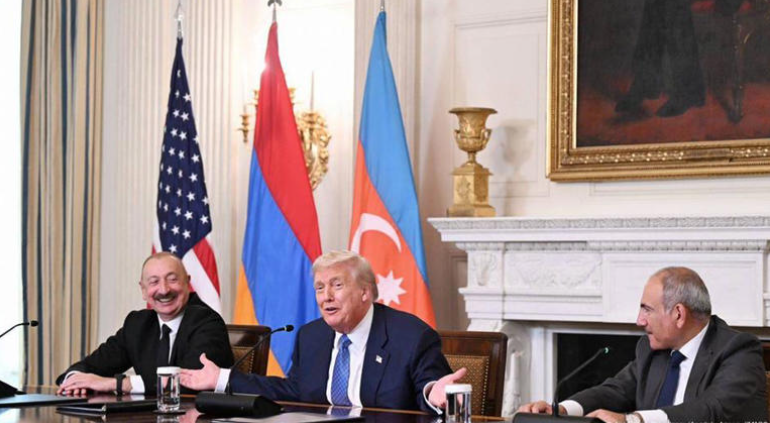Iran is openly opposing a new U.S.-brokered transit route in the South Caucasus, known as the Trump Route for International Peace and Prosperity . The plan connects Armenia and Azerbaijan in ways both countries say will improve trade and security. But for Iran, this is more than a transport project it is a challenge to its regional power, economic access, and strategic influence.
What the “Trump Route” Means for the Region
The TRIPP corridor is designed as a modern, multi-use transport link. It will include new highways, rail lines, oil and gas pipelines, and advanced fiber-optic networks. By giving Azerbaijan a direct land route to Nakhchivan, it creates an alternative to existing connections that pass through Iran.

For Armenia, the deal offers new infrastructure and a chance to normalize relations with its neighbor after years of hostility.
Iran, however, sees all of this as a potential loss. If major energy and trade flows move through Armenia instead of Iran, Tehran’s role as a regional gateway could shrink dramatically.
Tehran Labels the Corridor a Geopolitical Threat
Iranian leaders wasted no time in condemning the corridor. Ali Akbar Velayati, a senior adviser to Supreme Leader Ayatollah Ali Khamenei, warned that the TRIPP route would never operate freely if it undermines Iran’s security. “This passage will not become a gateway for Trump’s mercenaries it will become their graveyard,” he declared.
Velayati argued that the U.S.-backed plan is not about peace but about pushing Iran and Russia out of the South Caucasus. He said Tehran would resist “with or without Russia,” signaling that even without full Moscow support, Iran is prepared to act on its own.
Iran’s Official Diplomacy Strikes a Cautious Tone
While hardliners made aggressive statements, Iran’s Foreign Ministry adopted a more measured approach. Officials welcomed the broader Armenia Azerbaijan peace agreement, but carefully avoided endorsing the TRIPP corridor.

The ministry warned against foreign interference in the region and repeated its support for the “3+3″ regional cooperation format uniting Armenia, Azerbaijan, Georgia, Iran, Turkey, and Russia. This approach allows Tehran to publicly favor peace while privately preparing strategies to counter U.S. influence.
Hardline Figures Push for Military Readiness
Iranian political and military hawks are already urging the government to prepare for confrontation. In past years, Iran staged large military drills near its northwestern borders whenever tensions with Azerbaijan rose.
Velayati hinted at such options again, recalling exercises that demonstrated Iran’s readiness to defend “territorial integrity and regional stability.” For these hardliners, the TRIPP corridor is not only an economic threat—it is a security risk that could open the door to U.S. military or intelligence presence in the Caucasus.
Strategic Stakes for Iran, Russia, and Neighbors
For Iran, the corridor could cut its role as a main overland link between the Caucasus and Europe. Goods, pipelines, and digital infrastructure could bypass Iranian territory entirely. This would weaken its bargaining power in regional trade talks and reduce the transit fees that help fund its economy.
Russia also stands to lose. The U.S. presence could chip away at Moscow’s traditional role as the main power broker between Armenia and Azerbaijan. A stronger U.S.–Azerbaijan link could also complicate Russia’s military presence in Armenia.
For Armenia, the corridor is both an opportunity and a risk. It could attract investment and lower tensions with Azerbaijan, but it may also provoke Iran, an important neighbor and energy supplier.


 Trump meets with Intel CEO after demanding he resign
Trump meets with Intel CEO after demanding he resign  Trump Says He’ll Quickly Know if Putin Wants Peace on Ukraine
Trump Says He’ll Quickly Know if Putin Wants Peace on Ukraine  Trump Secures Peace Deal Between Armenia and Azerbaijan
Trump Secures Peace Deal Between Armenia and Azerbaijan  Trump Fires IRS Chief Billy Long After Less Than Two Months
Trump Fires IRS Chief Billy Long After Less Than Two Months  Trump and Putin Will Meet to Discuss the War in Ukraine
Trump and Putin Will Meet to Discuss the War in Ukraine  Iran Calls for U.S. Accountability Over Attacks on Nuclear Sites
Iran Calls for U.S. Accountability Over Attacks on Nuclear Sites